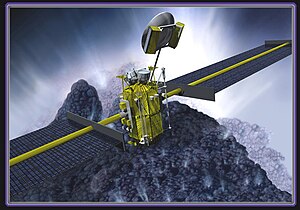Champollion (spacecraft)
 Single spacecraft concept of Champollion | |||||||||||||||
| Names | Deep Space 4 Space Technology 4 | ||||||||||||||
|---|---|---|---|---|---|---|---|---|---|---|---|---|---|---|---|
| Mission type | Comet exploration | ||||||||||||||
| Operator | NASA / CNES[1] | ||||||||||||||
| Mission duration | Cancelled | ||||||||||||||
| Spacecraft properties | |||||||||||||||
| Launch mass | 1,051 kg (2,317 lb)[2] | ||||||||||||||
| Power | 10,000 watts[2] | ||||||||||||||
| Start of mission | |||||||||||||||
| Launch date | April 2003 Planned | ||||||||||||||
| Rocket | Delta II–7925 | ||||||||||||||
| Launch site | Cape Canaveral | ||||||||||||||
| Rendezvous with 9P/Tempel | |||||||||||||||
| Arrival date | February 2006[1][2] Planned | ||||||||||||||
| Transponders | |||||||||||||||
| Bandwidth | X-band: 50 kbit/s[2] | ||||||||||||||
| |||||||||||||||
Champollion was a planned cometary rendezvous and landing spacecraft. It was named after Jean-François Champollion, a French Egyptologist known for translating the Rosetta Stone.
Rosetta surface science package
[edit]As originally envisaged, the joint NASA/CNES Champollion was to be one of two surface science packages for the Rosetta mission to comet Wirtanen, alongside the German-led RoLand. Champollion was to provide for return of cometary samples to Earth.
This part of the Rosetta mission was withdrawn in late 1996 due to lack of funding from JPL.
Deep Space 4 / Space Technology 4
[edit]
Champollion was revived under NASA's New Millennium Program as Deep Space 4 / Space Technology 4, again as a joint project of NASA and CNES. In this version, Champollion would be a stand-alone project consisting of an orbiter and a lander, with the focus shifted somewhat to engineering validation of new technologies rather than pure science.
As of March 1999,[3] the baseline mission was to launch in April 2003, reaching comet Tempel 1 in 2006. The sample return element of the mission was at this point contingent on sufficient funding/resources, possibly being replaced with a demonstration of related capabilities.
The lander was approximately 1.5m high weighing 160 kg; it was to autonomously navigate to the comet from 50 km altitude and anchor itself with a spike. The planned payload included:
- CHARGE, a gas chromatograph/mass spectrometer
- CIRCLE, cameras/microscope/IR spectrometer
- CIVA, panoramic cameras
- CPPP, "physical properties probes" to be driven into the cometary surface
- SATM drill mechanism
- gamma ray/neutron spectrometer
The orbiter was to carry cameras and a dust monitor.
Later in 1999, Space Technology 4 was scaled back to a single spacecraft[4] with no sample return; it was cancelled entirely on July 1, 1999, due to budgetary constraints.[5]
See also
[edit]- Deep Impact (spacecraft) (Comet impactor mission)
- Stardust (spacecraft) (Comet coma sample-return)
References
[edit]- ^ a b Paul R. Weissman (2000). "The Deep Space 1 and Space Technology 4/Champollion Missions". NASA / JPL. Retrieved October 15, 2024.
- ^ a b c d Gunter D. Krebs. "Champollion (ST 4)". Gunter's Space Page. Retrieved October 15, 2024.
- ^ P. R. Weissman; W. D. Smythe; B. K. Muirhead; G. H. Tan-Wang; D. Sabahi; J. M. Grimes (March 15–29, 1999). The Deep Space 4/Champollion Comet Rendezvous and Lander Technology Demonstration Mission. 30th Annual Lunar and Planetary Science Conference. Houston, Texas, USA. p. 1142. Bibcode:1999LPI....30.1142W.
- ^ John G. Watson (April 30, 1999). "Fast Response Keeps Champollion On Track". JPL. [permanent dead link]
- ^ "The New Millennium Program: Space Technology 4". nmp.jpl.nasa.gov. NASA / JPL. July 1, 1999. Archived from the original on December 9, 2004. Retrieved November 24, 2004.
External links
[edit] Media related to Champollion (spacecraft) at Wikimedia Commons
Media related to Champollion (spacecraft) at Wikimedia Commons
